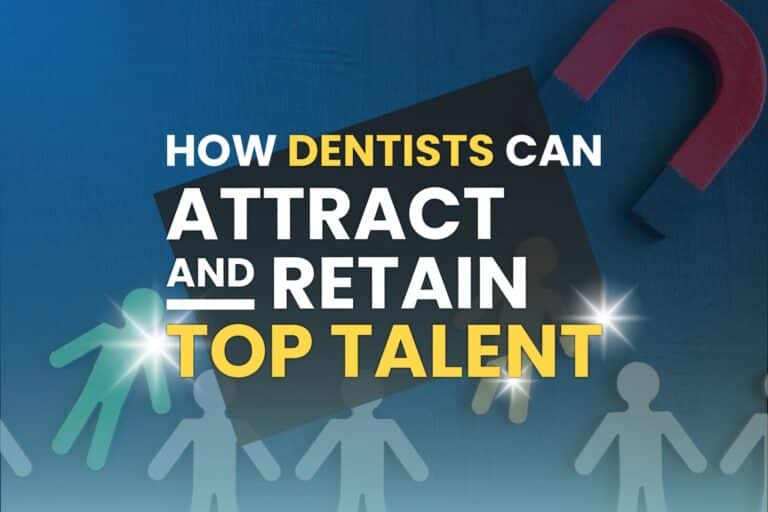More dentists than ever want to treat full-arch patients. And small wonder — with insurance payouts falling, labor costs up, and nearly ten thousand older adults retiring every day, the full-arch market offers the kind of growth opportunity many ambitious practice owners can’t turn down.
But we’ve seen what happens when dentists go about trying to add full arch without first making the necessary preparations. And make no mistake — if you turn on the marketing spend before you have an effective operations and sales process to convert your marketing leads into new patients, then you’re going to waste your time and money.
You can easily spend $10,000, even $20,000 a month generating hundreds of potential patients or leads, only to watch in horror as none of them become patients. And that hurts.
So before you do that, read our list of essential questions to help you assess whether your operational and sales capabilities are up to the task of converting your leads into consults and then patients. This list is far from exhaustive — there’s a lot more to mastering the full-arch game than what we’re covering here — but it will give you a good snapshot of where you stand.
1. Do you understand your new patient journey (and everything that can go wrong)?
A basic full-arch new patient journey goes like this:
- A potential new patient sees your ad and visits your landing page to request more information.
- Your team calls the patient to answer their questions and ask them to schedule a consult.
- The potential patient comes in for a consult, meets your doctor, and gets a treatment plan.
- The patient accepts the plan and begins treatment.
Except… when is it ever that simple? Think about how many failure points there are even on a basic journey. Here are a few examples:
- The patient may not respond to your team’s phone call.
- The patient may decline to schedule a consult when they do pick up the phone.
- The patient may schedule, but then not show up for their consult.
- The patient may not be able to afford treatment.
- The patient may not understand the value you provide.
- The patient may feel frustrated by poor communication between the doctor and treatment coordinator.
- The patient may show up for an initial consult and even appear enthusiastic, but then disengage.
Even if everything goes right, a patient may still need months after their initial expression of interest before they are ready to start treatment. (Would you spend $20,000+ without putting some serious thought into it first? No? Most dental patients wouldn’t either — and that’s assuming they can afford to spend it in the first place.)
This is why it’s so important that you understand everything that a potential full-arch patient goes through on their way to starting treatment. That way, you know what you need to do to support them through it.
👉 Full Arch Advantage Podcast: Watch dozens of interviews with leading full-arch dentists, marketers, and sales experts.
2. Do you have a CRM in place and if so, does it fit your needs?
A contact relationship management platform, or CRM, while valuable for any dentist, is essential for anyone who wants more full-arch patients. It’s a tool you can use to manage your relationships at scale — to track all your interactions with every single full-arch lead from the moment they engage with your marketing until after they have become a patient.
And no, it’s not the same thing as a PMS. Your PMS is built to handle the clinical side of things, while a CRM is made specifically to help marketing and sales. A good CRM will integrate with your PMS so you don’t have to manage two separate databases, but neither one can replace the other.
Used correctly, a CRM can help you exponentially increase your full-arch sales. You’ll be able to nurture your leads over time, build relationships with patients until they’re ready to accept treatment and identify gaps in your patient journey that need improvement.
Of course, not all CRMs are created equal. Look for one that’s HIPAA-compliant. Ideally, it should also share data with your PMS, and feel easy and intuitive to use. A few recommendations:
- Trackable. Built just for dentists and is the only CRM we know of that integrates with your PMS. We use it with all of our clients.
- HighLevel. Also popular with marketing and other healthcare professionals, although it doesn’t connect to your PMS.
- Salesforce. Leading CRM used by large corporations and tech companies (also doesn’t connect to PMS).
There are other options, but we consider these three a good place to start. (Please note that the popular and otherwise excellent HubSpot, which we use for our own B2B marketing and sales, is not HIPAA compliant and so isn’t suitable for generating new patients.)
3. Do you know how to answer the phone and quickly schedule?
A potential full-arch patient calls your practice. Does your team know how to answer?
Phone conversion is a big deal for all dentists — and a make-or-break inflection point for your marketing even for GP patients. But this goes doubly true for full-arch leads because how you handle your calls gives you the opportunity to qualify each lead (determine whether they are local and can likely afford treatment) before they even arrive at your practice.
In order to succeed on the phones, your team needs a different strategy from the one you use to bring in GP patients. First, your call handlers need to know enough about full-arch treatment in order to establish credibility with callers, many of whom will have done significant research into the subject on their own. (For better or worse — we say mostly better — the days of dentists as the sole source of truth on dental procedures are far behind us.)
Second, you’ll need to know how to handle questions about price. While we typically recommend that you don’t discuss pricing for GP procedures over the phone, you may wish to provide a price range when talking about full arch as doing so will help both potential patients and your team decide if there is room to move forward before committing to a consult. (Talking price also allows you to mention your financing options.)
Finally, you’ll want to use gentle sales tactics like a dual alternative close to nudge qualified callers into scheduling a consult — and your team needs to know how to do that.
Oh, and before we forget, you’ll also need to figure out how quickly you can schedule a patient who is ready to move forward for a full-arch consult. And if the answer is longer than 1-2 business days, you need to change that (try leaving open consult blocks in your schedule each day so you can always accommodate requests).
There is too much competition in the full-arch space for you to get away with keeping patients waiting for more than a little while.
4. Do you have a lead nurturing process in place?
This goes hand in hand with using a CRM. Once you have a CRM in place, you need someone (or more than one person) to actually use it to keep in contact with all the new full-arch leads you’re connecting with via your ad campaign.
As we’ve already said, most of those leads, even the ones who can afford treatment, won’t simply schedule a consult, show up, sign on the dotted line, and start the next week. Getting those patients from maybe to yes is a process — one that takes time.
You can use your CRM to streamline and automate much of this lead nurturing, from sending drip marketing email campaigns to regular messages from your treatment coordinator and even scheduling phone calls. You’ll also be able to view all of these contacts within the system, along with any notes about what each potential patient has said during calls or consults.
5. Do you have enough manpower to handle lead nurturing?
This is directly related to our previous question, but it’s so important that we’re giving it a separate section. If you’re going to do lead nurturing, you need a team with enough bandwidth to actually handle all the work involved.
You’ll likely need to invest at least 10-12 hours a week in order to generate a handful of full-arch starts each month. This time will largely be spent on the phone, making follow-up calls to potential patients who have expressed interest in treatment by asking for more information or showing up for a consult.
That 10-12 hours a week figure will only go up if you want a higher volume of full-arch cases, too. Many practices will need to either hire an additional front desk person to handle the calls or outsource their lead nurturing functions. (We handle all lead nurturing for our clients.)
6. Do you have financing options lined up?
You’re selling a treatment that costs more than many cars. Unless your practice is in Manhattan or Beverly Hills, many of your patients will need financing in order to pay for it.
And as you probably already know… if a patient can’t afford treatment and you can’t help them bridge the gap, then you’re almost certainly going to lose the patient. While some may be able to turn to credit cards, bank loans, lines of credit, or other personal loans, many traditional lenders are more wary of funding healthcare costs than they would be backing a mortgage or an auto loan.
After all, you can’t repossess an implant or a bridge. (At least, we truly hope not!)
You’ll be significantly improving your own case acceptance rates if you make it easier for patients to pay for the care they need. And that typically means partnering with a healthcare financing company.
We recommend Proceed Finance to our own full-arch clients. You may also wish to consider offering in-house financing to patients who need just a little bit of help getting over the top.
Skipping this step will substantially reduce your overall pool of potential patients and make it harder for your treatment coordinator to close cases — even those who may be able to come up with enough money on their own.
7. Do you have a treatment coordinator who knows how to sell (and have you figured out how to compensate them for doing it)?
Let’s be blunt: Full-arch dentistry is a sales game. Yes, it’s about improving a patient’s quality of life and yes, it takes an enormous amount of clinical skill to do the actual procedure, but neither of those things matter unless you can convince a potential patient to go for it.
And that’s about sales.
So in order to sell, you need a treatment coordinator who understands how to do it. People skills are a must, as are empathy, a non-judgmental attitude, and genuine bravery (it isn’t easy to present a $50,000 treatment plan).
But beyond these key personality traits, your treatment coordinator also needs to have a coherent sales process that he or she can lead your full-arch patients through from beginning to end. This means understanding sales psychology, a carefully laid out strategy for both clinical and case presentations, agreed-upon areas of responsibility with the doctor, a procedure for smooth handoffs and transitions between team members, and more.
And since it’s a sales role, you should be seriously considering incentivizing them to sell by offering a commission for every arch sold. While some practices only pay a base salary, you’re likely going to get better results if you offer a base plus commission structure.
Sales is hard work and anyone with the skills to do it well will want a piece of the action.
👉 Master the full-arch sales process: Sign up for Full Arch Sales Academy so Stacy Farley can teach you how she sells 60+ arches each month.
8. Do you have a clear UVP (unique value proposition)?
As we said above, more dentists than ever are getting in on full arch. This means you’ve got to figure out how to make your practice stand out from the crowd.
This starts with developing what’s called a unique value proposition, or UVP. Your UVP is the essence of your marketing — the reason why a potential patient should choose your practice over the guys down the road.
A good UVP will highlight your strengths. For example, depending on what those are, you may want to consider factors like:
- Time. You might emphasize how your All-on-4s are faster to complete than other implant techniques.
- Convenience. Patients will love it if you offer everything under one roof so they don’t have to go back and forth between an oral surgeon and their regular dentist.
- Lifetime guarantee. Who won’t be impressed by the fact that your work is so good you’ll back it for life?
These are just examples, of course. Your specific UVP can be different. It just needs to be true, attractive, and something you feel comfortable putting at the center of your marketing efforts.
9. What are your current conversion and case acceptance rates?
If you’ve got a good CRM in place by now, then you should be able to track all of your essential KPIs for your entire full-arch patient journey. And if not, go back to question 2!
Knowing your existing conversion rates for your entire funnel — from the number of raw leads you create to how many are qualified leads to how many schedules, show up for consults, and then go on to become patients — will allow you to establish a baseline level of performance. From there, you can identify any areas that need improvement.
Over time, this will not only allow you to generate more patients, but significantly lower your per-patient acquisition costs. For full arch, specifically, this can often result in hundreds or even thousands of dollars of savings for every single new patient.
10. What are your growth goals for the year?
This one’s short but important. Before you invest in marketing, you need to know what you actually want to achieve.
Set specific growth goals (new full-arch patients, collections, etc) for the year or on a quarterly basis. That way, whether you decide to work with an outside marketing partner or go it alone, you’ll have clear bottom-line KPIs to shoot for.
Having those goals will help motivate you and your team to work towards them.
11. Start building a marketing strategy to achieve them
It’s only now that we’re actually getting to marketing. See everything that comes before it?
Here, you want to create a full-arch marketing strategy that walks your potential patients through 3 key phases:
- Educate. Help your leads become aware of full-arch treatment and begin to understand how it could help improve their quality of life.
- Validate. Connect with potential patients who want full-arch treatment and are actively looking for a practice to provide it.
- Cultivate. Build relationships with patients who are specifically considering your practice so that they’ll schedule a consult and then start treatment.
Obviously, there’s a lot to unpack here. Rather than try and cram it all into this article, we suggest you read our guide to building a winning full-arch marketing funnel.
Get help
We’ll teach your team to master full-arch operations and sales — and then knock your marketing out of the park. Start with a free growth consult to learn more.






